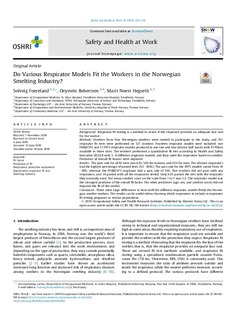| dc.contributor.author | Føreland, Solveig | |
| dc.contributor.author | Robertsen, Øystein | |
| dc.contributor.author | Hegseth, Marit Nøst | |
| dc.date.accessioned | 2019-09-17T08:00:55Z | |
| dc.date.available | 2019-09-17T08:00:55Z | |
| dc.date.created | 2019-07-17T10:39:50Z | |
| dc.date.issued | 2019 | |
| dc.identifier.citation | SH@W Safety and Health at Work. 2019, 10 (3), 370-376. | nb_NO |
| dc.identifier.issn | 2093-7911 | |
| dc.identifier.uri | http://hdl.handle.net/11250/2617119 | |
| dc.description.abstract | Background
Respirator fit testing is a method to assess if the respirator provides an adequate face seal for the worker.
Methods
Workers from four Norwegian smelters were invited to participate in the study, and 701 respirator fit tests were performed on 127 workers. Fourteen respirator models were included: one FFABE1P3 and 11 FFP3 respirator models produced in one size and two silicone half masks with P3 filters available in three sizes. The workers performed a quantitative fit test according to Health and Safety Executive 282/28 with 5–6 different respirator models, and they rated the respirators based on comfort. Predictors of overall fit factors were explored.
Results
The pass rate for all fit tests was 62%, 56% for women, and 63% for men. The silicone respirators had the highest percentage of passed tests (92–100%). The pass rate for the FFP3 models varied from 19–89%, whereas the FFABE1P3 respirator had a pass rate of 36%. Five workers did not pass with any respirators, and 14 passed with all the respirators tested. Only 63% passed the test with the respirator they normally used. The mean comfort score on the scale from 1 to 5 was 3.2. The respirator model was the strongest predictor of the overall fit factor. The other predictors (age, sex, and comfort score) did not improve the fit of the model.
Conclusion
There were large differences in how well the different respirator models fitted the Norwegian smelter workers. The results can be useful when choosing which respirators to include in respirator fit testing programs in similar populations. | nb_NO |
| dc.language.iso | eng | nb_NO |
| dc.publisher | Elsevier | nb_NO |
| dc.relation.uri | https://www.sciencedirect.com/science/article/pii/S2093791118304864 | |
| dc.rights | Attribution-NonCommercial-NoDerivatives 4.0 Internasjonal | * |
| dc.rights.uri | http://creativecommons.org/licenses/by-nc-nd/4.0/deed.no | * |
| dc.title | Do Various Respirator Models Fit the Workers in the Norwegian Smelting Industry? | nb_NO |
| dc.type | Journal article | nb_NO |
| dc.type | Peer reviewed | nb_NO |
| dc.description.version | publishedVersion | nb_NO |
| dc.source.pagenumber | 370-376 | nb_NO |
| dc.source.volume | 10 | nb_NO |
| dc.source.journal | SH@W Safety and Health at Work | nb_NO |
| dc.source.issue | 3 | nb_NO |
| dc.identifier.doi | 10.1016/j.shaw.2019.06.004 | |
| dc.identifier.cristin | 1711748 | |
| dc.relation.project | Norges forskningsråd: 245216 | nb_NO |
| dc.description.localcode | Open Access CC BY-NC-ND 4.0 | nb_NO |
| cristin.unitcode | 194,64,90,0 | |
| cristin.unitcode | 1920,8,0,0 | |
| cristin.unitname | Institutt for geovitenskap og petroleum | |
| cristin.unitname | Klinikk for lunge og arbeidsmedisin | |
| cristin.ispublished | true | |
| cristin.fulltext | original | |
| cristin.qualitycode | 1 | |

